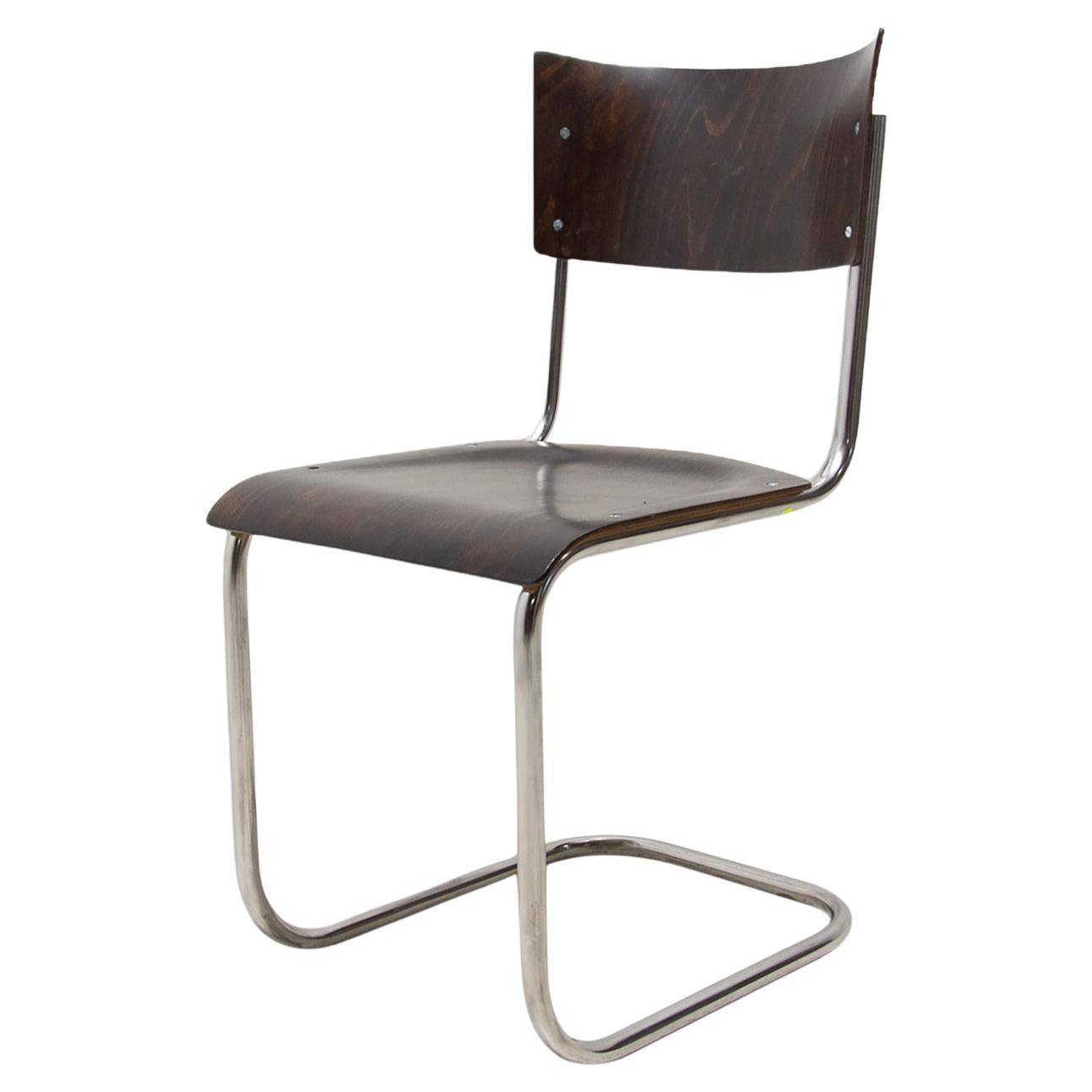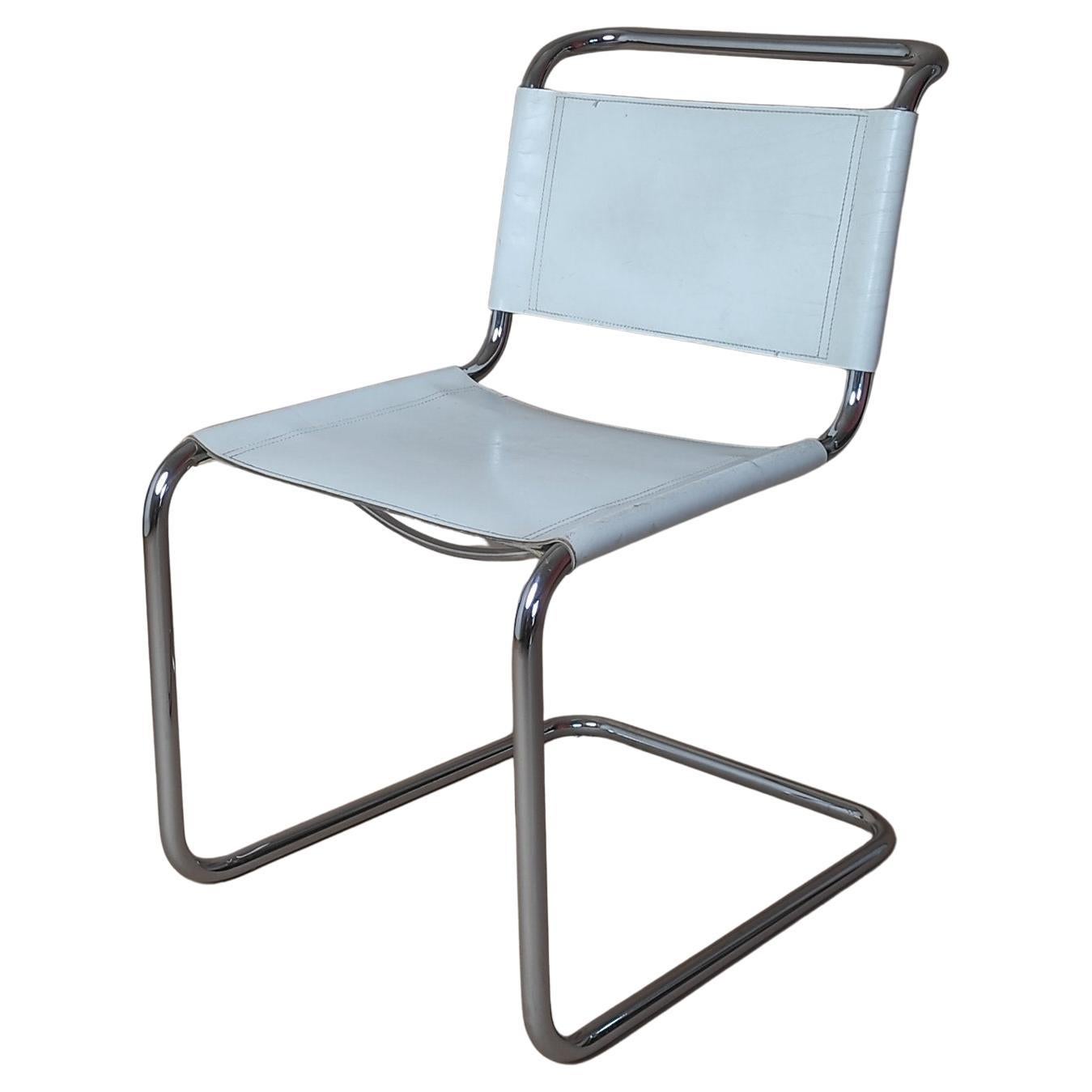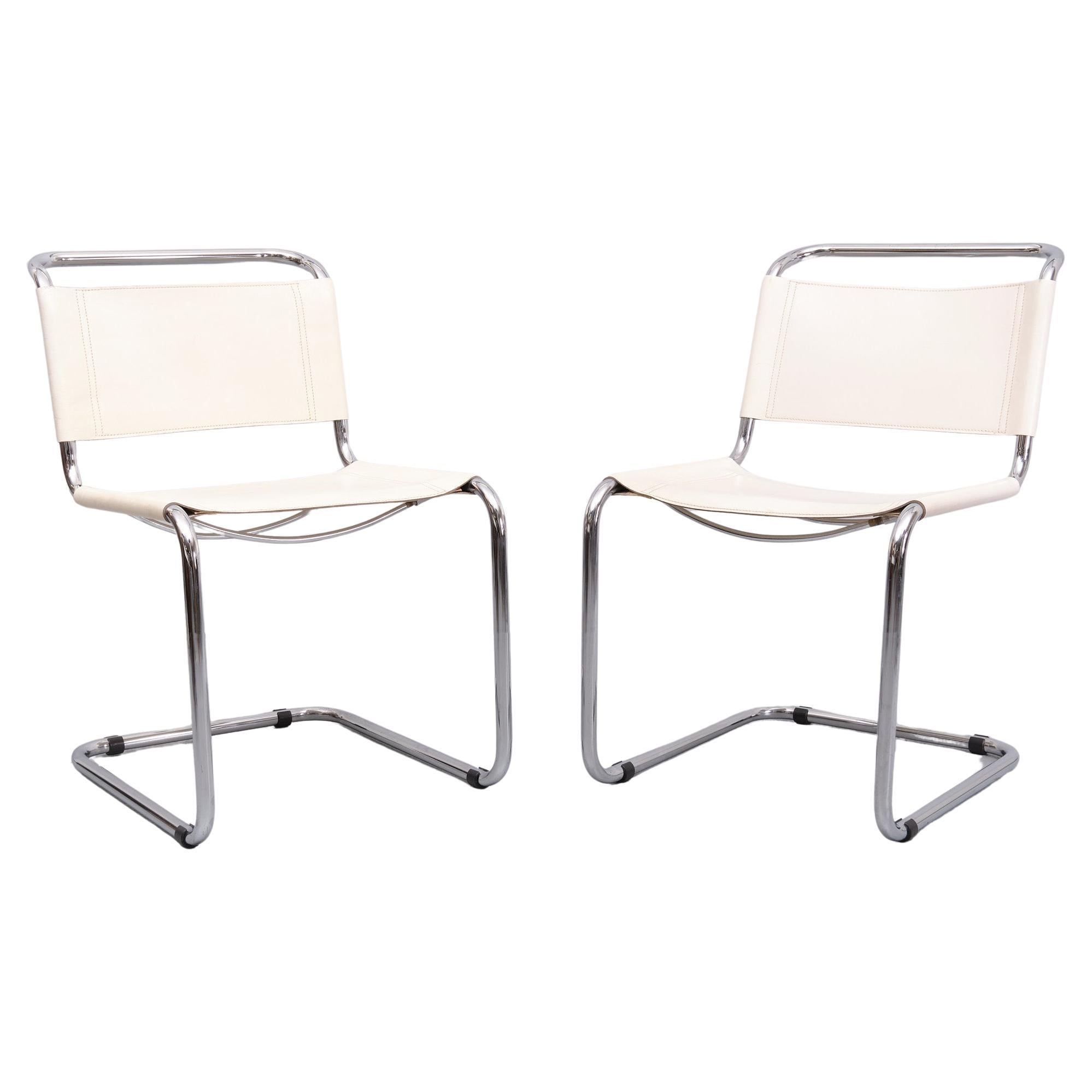Items Similar to Vintage German Bauhaus Icon Black Leather & Chrome S33 Chair by Mart Stam, 1960s
Want more images or videos?
Request additional images or videos from the seller
1 of 17
Vintage German Bauhaus Icon Black Leather & Chrome S33 Chair by Mart Stam, 1960s
About the Item
This S33 chair by Mart Stam is a design icon from 1926. It was produced by the German Thonet manufactory. Our piece comes from the 1960s. It is the first cantilever chair in the history. Mart Stam experimented with gas pipes which he connected by flanges and developed the form of chairs that no longer rest on four legs. In this way, he created a construction principle that has become an important element in the history of modern furniture design. This chair is made of tubular steel, over which black natural leather has been stretched. This chair combines the spirit of the Bauhaus school and the awareness of tradition. Why four legs, when two are enough - wrote the artist Kurt Schwitters in 1927, when he saw the first cantilever chairs in history. This piece has a label under the seat, but now is just a traces after this label.
Mart Stam was a Dutch architect, town planner and furniture designer. His career coincides with important moments in the history of European architecture of the 20th century. He is credited with part of the design of the Van Nelle Factory in Rotterdam, built between 1926 and 1930. This coffee and tea factory is still a powerful example of early modern industrial architecture. New research indicates that Stam was inspired by the cantilever tubular steel seat fitted to the 1926 Tatra T12 two-door saloon. Ludwig Mies van der Rohe found out about Stam's work on the chair during the planning of the Weissenhof Siedlung and mentioned it to Marcel Breuer. This led to a variation on the cantilever steel chair and ushered in an entire genre of design. In the late 1920s, Breuer and Stam were involved in a patent process in German courts, both claiming to be the inventors of the basic principle of cantilever chair design. Stam won the lawsuit. In the US, Breuer assigned the rights to his designs to Knoll and for this reason you can find an identical chair attributed to Stam in Europe and Breuer in the USA.
Mart Stam designed a house for the Weissenhof estate from 1927, a permanent housing project developed and presented at the Die Wohnung exhibition, organized by Deutscher Werkbund in Stuttgart. This placed him in the company of crème de la crème of the architectural circles, i.e. Le Corbusier, Peter Behrens, Bruno Taut, Hans Poelzig and Walter Gropius.
Thonet is the oldest existing furniture company in the world. It began its long business in 1819 when the carpenter Michael Thonet founded a furniture workshop in Boppard, Germany. A supporter of the Biedermeier style, he specialized in chairs, tables and cabinets characterized by clean lines, reduced ornamentation and an emphasis on the principles of functionalism. In the 1930s, Thonet's experiments with glued and steam-bent wood furniture, such as his famous Boppard chair (1836), brought international acclaim. Thonet's projects achieved lightness, durability and comfort unprecedented in European furniture at that time. The iconic works of the Thonet collection include: rocking chair No. 1 (1860), cafe chair No. 14 (c. 1859), chair of the Adolf Loos cafe museum (1899), chair No. 209 (c. 1900), Otto Wagner's chair No. 247 (1904) and Josef Hoffmann's No. 811 (1925). In the early 1920s, Gebrüder Thonet also began producing bent tubular steel designs by Bauhaus masters such as Marcel Breuer, Ludwig Mies van der Rohe, and Mart Stam.
This chair is in original vintage condition. It has minor scratches on the leather and a natural patina. Measure: The seat is 43 cm high.
- Creator:
- Dimensions:Height: 33.47 in (85 cm)Width: 19.3 in (49 cm)Depth: 23.63 in (60 cm)Seat Height: 16.93 in (43 cm)
- Style:Bauhaus (In the Style Of)
- Materials and Techniques:
- Place of Origin:
- Period:
- Date of Manufacture:circa 1960
- Condition:Wear consistent with age and use. This chair is in original vintage condition. It has minor scratches on the leather and a natural patina.
- Seller Location:Warszawa, PL
- Reference Number:1stDibs: LU6129226662422
About the Seller
5.0
Gold Seller
These expertly vetted sellers are highly rated and consistently exceed customer expectations.
Established in 2010
1stDibs seller since 2021
36 sales on 1stDibs
Typical response time: <1 hour
- ShippingRetrieving quote...Ships From: Warszawa, Poland
- Return PolicyA return for this item may be initiated within 14 days of delivery.
More From This SellerView All
- Vintage Germany Icon Bauhaus B35 Black Leather Chair by Marcel Breuer for ThonetBy Marcel Breuer, ThonetLocated in Warszawa, MazowieckieThis design icon from 1928, the B35 armchair, was designed by Marcel Breuer in the late 1920s and made by the German Thonet factory in the early 1930s. This piece is made of tubular steel and black leather with natural patina. The materials used and the traces of wear show that this is an early production of this timeless modell. The armrests are finished with solid wood. Following the success of his Wassily chair, Breuer continued to experiment with tubular steel furniture. Like the Wassily chair, the B35 was not a direct representative of the Bauhaus school, but is clearly in line with the Bauhaus design and construction principles, with a modern, stripped-down form made of industrial materials not used today in furniture production. Marcel Breuer was born in 1902 in Hungary. He was an architect and designer. He received a scholarship to study painting and sculpture at the Vienna Academy of Fine Arts in 1920, but quickly quit and applied to the Bauhaus school in Weimar, Germany. After completing the preliminary courses there, he studied at the Bauhaus furniture...Category
Vintage 1930s German Bauhaus Armchairs
MaterialsChrome
- Vintage Bauhaus Skaala Fabric & Chrome Chair by Yrjö Kukkapuro, 1980s, Set of 4By Yrjö Kukkapuro, Avarte, Finland 1Located in Warszawa, MazowieckieThis set of four Skaala chairs was designed by Yrjö Kukkapuro for the Finnish Avarte manufacture during the 1980s. Due to their modern and minimal look, they will easily find their place in the living room or office. The Skaala chair perfectly reflects Kukkapuro's love for ergonomic furniture. This innovative combination of aesthetics and functionality refers to idea from Bauhaus school. The frame is made of chrome-plated goldish metal. The seat and backrest are upholstered with high-quality gray fabric, and additional armrests are made of birch plywood. Yrjö Kukkapuro is a Finnish furniture designer. He is the important person of Finnish functionalism. He has mainly been working as a freelance designer since the 1950s, and most of the furniture he designed early in his career is still in production. "Does it make sense to design a chair that is not comfortable to sit on?" - this is one of Kukkapuro's favorite sayings, which perfectly reflects the designer's love of ergonomic furniture. His designs aim at a subtle balance between functionality and aesthetics - a perfect example of this is the Karuselli chair by Artek and other iconic designs such as the Saturnus table, the Skaala chair, the Remmi series, and the Ateljee armchair and sofa. In his career, Kukkapuro has received many national and international awards - incl. Lunning Prize in 1966, First Prize at the International Chair Design Competition in Italy in 1972 and the Kaj Franck Design Prize in 1995. His works are permanently present in museums around the world, such as the Victoria and Albert Museum in London, MoMA in New York and Vitra Design Museum in Weil am Rhein, Germany. Avarte was established as a continuation of the family company Haimi. In 1980, Haimi employees acquired the company for themselves and changed the company name to Avarte. Haimi was a Finnish furniture manufacturer founded in 1943 that was especially known as the producer of Yrjö Kukkapuro designs. Avarte continued to manufacture furniture until 2013, when the company ha been ceased. In addition to Yrjö Kukkapuro's designs, Avarte also produced furniture designed by Samula Naamanka, Mikko Paakkanen and Simo Heikkilä...Category
Vintage 1980s Finnish Bauhaus Chairs
MaterialsChrome
- Vintage Mid-Century Modern Brown Leather Executive Chair by Arne Vodder, 1960sBy Arne VodderLocated in Warszawa, MazowieckieThis modernist chair was designed by the world-famous Danish designer Arne Vodder during the 1960s. The organic-shaped frame of the chair is made of solid wood with a noble, brown co...Category
Vintage 1960s Danish Scandinavian Modern Chairs
MaterialsLeather, Wood
- Rare Vintage Mid-Century German Modern Office Swivel Leather Easy Chair, 1960sLocated in Warszawa, MazowieckieThis office swivel armchair was manufactured in the Germany during the 1960s. The frame is made from metal. The chair is upholstered in real soft leather in black color. The headrest...Category
Vintage 1960s German Minimalist Office Chairs and Desk Chairs
MaterialsMetal, Chrome
- Pair of Vintage German Fabric & Aluminium Desk Chair from Fröscher SitformBy Fröscher SitformLocated in Warszawa, MazowieckieThis pair of modernistic armchairs was produced by the German manufactory Fröscher Sitform during the 1970s. The frame is made of solid aluminum. The ...Category
Vintage 1970s German Mid-Century Modern Office Chairs and Desk Chairs
MaterialsAluminum
- Pair of Midcentury German Modern Brown Aluminum Chairs from Mauser Werke WaldeckBy Mauser WerkeLocated in Warszawa, MazowieckieThis set of two modern chairs was manufactured in Mauser, Germany during the 1970s. The frame was made from solid anodized aluminum tubulars and it is characteristic for Mausers design. The upholstery is original and is in brow color. The seat is located on belts. The history of the Mauser company dates back to 1896, when Alfons Mauser opened a factory for metal products - Zaunkönig. In 1903, Mauser also developed hermetic, lockable iron...Category
Vintage 1970s German Modern Chairs
MaterialsMetal, Aluminum
You May Also Like
- Bauhaus Chair S43 by Mart Stam, 1930sBy Mart StamLocated in Prague 8, CZThis chair is one of the most famous and was designed in the 1930s by Mart Stam and made in the former Czechoslovakia in the 1950s. The chair has frames made of tubular chrome-plated...Category
Mid-20th Century Czech Bauhaus Office Chairs and Desk Chairs
MaterialsSteel, Chrome
- Mart Stam Leather S33 Chair 1970sBy Mart StamLocated in Čelinac, BAIf you are thinking about purchasing this great piece, feel free to ask for an additional video to be absolutely sure of your choice.Category
Vintage 1970s Italian Mid-Century Modern Chairs
MaterialsChrome
- S33 Leather Chairs By Mart Stam 1970sBy Mart StamLocated in Čelinac, BAMart Stam S33 Leather chairs Italy 1970sCategory
Vintage 1970s Italian Mid-Century Modern Chairs
MaterialsChrome
- pair Mart stam S33 cantilever chairs 1970sBy Mart StamLocated in Den Haag, NLTwo Original White Leather cantilever chair . Chrome Tube frame. 1970s Pioneering Dutch modernist architect-designer Mart Stam (1899-1...Category
Vintage 1970s Italian Mid-Century Modern Chairs
MaterialsLeather
- Restored Bauhaus Pair of Chairs, by Mart Stam, Chrome, Germany, 1930sBy Mart StamLocated in Horomerice, CZDesigned by Mart Stam, a renowned Dutch designer, and architect pivotal to mid-century design. Stam was a Dutch architect, urban planner, and furniture designer. Stam was extraordina...Category
Vintage 1930s Czech Bauhaus Chairs
MaterialsSteel, Chrome
- Modernist B43 Tabular Desk Chair by Mart Stam, 1950sBy Kovona, Mart StamLocated in Prague 8, CZThis B43 tubular desk chair was designed in 1931 by the world-renowned designer Mart Stam. It was made in the 1950s by Kovona company. The chair is ...Category
Mid-20th Century Czech Bauhaus Chairs
MaterialsChrome
Recently Viewed
View AllMore Ways To Browse
Leather No 1
German Leather
Chrome Chair Black
Chrome Black Leather
Chrome Leather Modern Chair
Leather Chairs With Chrome
Leather Chair With Chrome
Chrome Chair With Leather
Retro Leather And Chrome Chair
Vintage 1960s Leather
Furniture Ornamentation
Vintage Table With Chairs
Iconic Leather Chairs
Vintage Chrome Chair
1969 Chrome Chairs
1960s Chrome Chair
Black Leather Chair Chrome
Black Leather Chrome Chair





